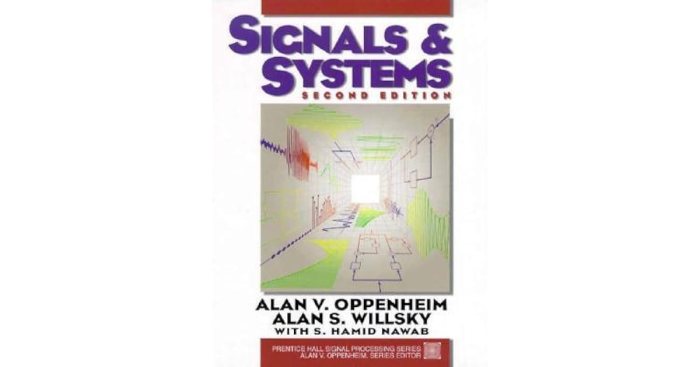Delve into the realm of Signals and Systems Oppenheim Solutions, an authoritative resource that unravels the intricacies of this captivating field. Embark on a journey of discovery, where complex concepts are illuminated with clarity and precision.
Signals and systems form the cornerstone of modern technology, enabling advancements in communications, control systems, image processing, and speech processing. This comprehensive guide provides a thorough understanding of the fundamental principles, applications, and problem-solving techniques in this dynamic discipline.
1. Introduction: Signals And Systems Oppenheim Solutions

Signals and systems play a crucial role in various fields, including communications, control systems, image processing, and speech processing. They provide a framework for understanding and analyzing the behavior of systems that process information, whether in the form of signals or data.
The book “Signals and Systems” by Oppenheim and Wilsky is a comprehensive textbook that introduces the fundamental concepts and applications of signals and systems. It covers a wide range of topics, from the basics of signal representation and analysis to advanced techniques such as Fourier and Laplace transforms.
Chapter 1: Introduction to Signals and Systems, Signals and systems oppenheim solutions
This chapter provides an overview of the basic concepts of signals and systems. It introduces the definitions of signals and systems, their classification, and the time-domain and frequency-domain representations of signals.
Chapter 2: Continuous-Time Signals
This chapter focuses on continuous-time signals, which are defined over a continuous time domain. It describes their properties, operations, and different types, including periodic, aperiodic, and random signals.
Chapter 3: Continuous-Time Systems
This chapter introduces the concept of continuous-time systems, which are characterized by their input-output relationship. It explains the concepts of linearity, time-invariance, and causality, and discusses the impulse response and frequency response of systems.
Chapter 4: Discrete-Time Signals
This chapter introduces discrete-time signals, which are defined over a discrete time domain. It explains the sampling process and its effects on signals, and discusses the properties and operations of discrete-time signals.
Chapter 5: Discrete-Time Systems
This chapter focuses on discrete-time systems, which are characterized by their input-output relationship. It explains the concepts of linearity, time-invariance, and causality in discrete-time systems, and discusses the difference between FIR and IIR filters.
Chapter 6: Fourier Analysis
This chapter introduces the Fourier transform, which is a powerful tool for analyzing signals in the frequency domain. It explains the properties of the Fourier transform and its applications in signal processing, such as filtering and spectral analysis.
Chapter 7: Laplace Transform
This chapter introduces the Laplace transform, which is another important tool for analyzing signals and systems. It explains the properties of the Laplace transform and its applications in system analysis, such as stability analysis and control system design.
Chapter 8: Z-Transform
This chapter introduces the Z-transform, which is a variant of the Laplace transform used for analyzing discrete-time signals and systems. It explains the properties of the Z-transform and its applications in digital signal processing, such as filter design and system analysis.
Chapter 9: Random Signals
This chapter introduces random signals, which are signals that exhibit random behavior. It explains the characteristics and analysis of random signals, and discusses the concept of power spectral density and its applications.
3. Applications
- Communications:Signals and systems are used in communication systems to transmit and receive information over various channels, such as wired networks, wireless networks, and optical fibers.
- Control systems:Signals and systems are used in control systems to regulate the behavior of physical systems, such as industrial machinery, robotic systems, and aircraft.
- Image processing:Signals and systems are used in image processing to enhance, analyze, and manipulate images, such as for medical imaging, remote sensing, and computer vision.
- Speech processing:Signals and systems are used in speech processing to analyze, synthesize, and enhance speech signals, such as for speech recognition, speaker recognition, and language translation.
Questions and Answers
What is the significance of signals and systems in modern technology?
Signals and systems play a crucial role in various technological advancements, including communications, control systems, image processing, and speech processing.
How does Signals and Systems Oppenheim Solutions help in understanding complex concepts?
This guide provides clear explanations, illustrative examples, and comprehensive coverage of fundamental principles and applications, making complex concepts accessible and understandable.
What are the key applications of signals and systems?
Signals and systems find applications in diverse fields such as communications, control systems, image processing, speech processing, and many more.


